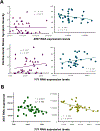Genes known to escape X chromosome inactivation predict co-morbid chronic musculoskeletal pain and posttraumatic stress symptom development in women following trauma exposure
- PMID: 30537437
- PMCID: PMC7138464
- DOI: 10.1002/ajmg.b.32706
Genes known to escape X chromosome inactivation predict co-morbid chronic musculoskeletal pain and posttraumatic stress symptom development in women following trauma exposure
Abstract
Co-morbid chronic musculoskeletal pain (CMSP) and posttraumatic stress symptoms (PTSS) are frequent sequelae of motor vehicle collision, are associated with greater disability than either outcome alone, and are more prevalent in women than men. In the current study we assessed for evidence that gene transcripts originating from the X chromosome contribute to sex differences in vulnerability to CMSP and PTSS after motor vehicle collision. Nested samples were drawn from a longitudinal study of African American individuals, and CMSP (0-10 numeric rating scale) and PTSS (impact of events scale, revised) outcomes were assessed 6 months following motor vehicle collision. Blood RNA were sequenced (n = 101) and the relationship between X chromosome mRNA expression levels and co-morbid CMSP and PTSS outcomes was evaluated using logistic regression analyses. A disproportionate number of peritraumatic X chromosome mRNA predicting CMSP and PTSS in women were genes previously found to escape X chromosome inactivation (11/40, z = -2.9, p = .004). Secondary analyses assessing gene ontology relationships between these genes identified an enrichment in genes known to influence neuronal plasticity. Further, the relationship of expression of two critical regulators of X chromosome inactivation, X-inactive specific transcript (XIST) and Yin Yang 1 (YY1), was different in women developing CMSP and PTSS. Together, these data suggest that X chromosome genes that escape inactivation may contribute to sex differences in vulnerability to CMSP and PTSS after motor vehicle collision.
Keywords: XIST; RNA; anxiety; hyperalgesia; sex differences.
© 2018 Wiley Periodicals, Inc.
Conflict of interest statement
Conflict of Interest
Authors declare no conflict of interest.
Figures



References
-
- Bellato HM, & Hajj GNM (2016). Translational control by eIF2α in neurons: Beyond the stress response. Cytoskeleton, 73(10), 551–565. - PubMed
Publication types
MeSH terms
Grants and funding
LinkOut - more resources
Full Text Sources
Medical

